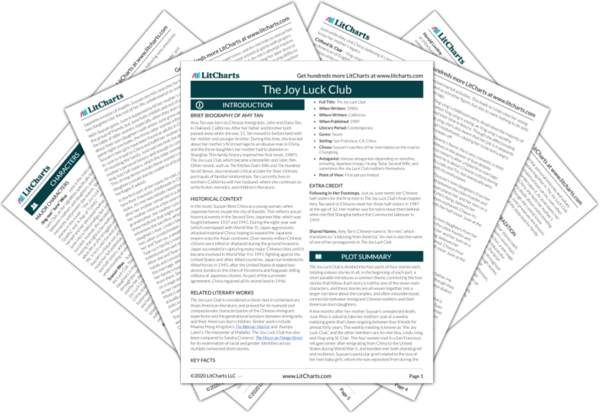Mother-Daughter Relationships
The main focus in The Joy Luck Club is the complex relationship between mothers and daughters, and the inherent bond that’s always between them despite generational and cultural conflicts. The novel follows June Woo’s search to understand her deceased mother Suyuan’s life, supplemented by stories from her mother’s three best friends, Lindo, An-mei, and Ying-ying. June’s memory of her mother is complicated by the revelation that Suyuan had twin baby…
read analysis of Mother-Daughter RelationshipsStorytelling and Tradition
The novel has four sections of four stories each, narrated in turn by one of the novel’s seven main characters. At the start of each section, a one-page Chinese parable (a short story with a moral) introduces the theme that connects the four stories that follow. The brief parables reflect the mothers’ own parenting styles throughout the book, as they teach their daughters lessons through stories that can be internalized, rather than direct opinions or…
read analysis of Storytelling and TraditionImmigration, Language, and Mistranslation
Though storytelling is the main mode of communication in The Joy Luck Club, a constant conflict in the novel is the language barrier between Chinese and English. When first immigrating to the United States, the mothers wish for their children to speak perfect English and succeed as Americans. However, by assimilating into American culture, their daughters lose a sense of their Chinese heritage and inherited language, in fact they lose even the ability to…
read analysis of Immigration, Language, and Mistranslation
Fate and Autonomy
The notion of fate permeates the novel, as the protagonists waver between the traditional acceptance of a singular destiny and the opportunity to decide their own fates. The mothers often refer to the Chinese belief of predetermined outcomes; in particular, they regularly mention Chinese zodiac characters established by birthdates, which supposedly dictate personalities and personal weaknesses. Still, a common thread in all the stories is the ability to break out of one’s preordained life to…
read analysis of Fate and AutonomySacrifice
The Joy Luck Club shows that all actions of love require some level of sacrifice, and that women in particular sacrifice themselves for the good of others. The greatest sacrifice in the book is Suyuan’s decision to leave her twin babies in a safe spot to be rescued during the Japanese invasion of Kweilin. Nearly dead herself from dysentery, she places them near a road along with all her remaining money and her husband’s…
read analysis of SacrificeSexism and Power
As a novel centered entirely on women’s points of view, The Joy Luck Club grapples with the nuances of sexism. On an explicit scale, the forced marriage of Lindo to her childish husband, Tyan-yu, shows the powerlessness of being a woman in pre-modern China. Without any say in her future, Lindo is used as barter to please a more powerful family. Sexual assault and domestic abuse feature in each of the mothers’ personal histories…
read analysis of Sexism and Power











